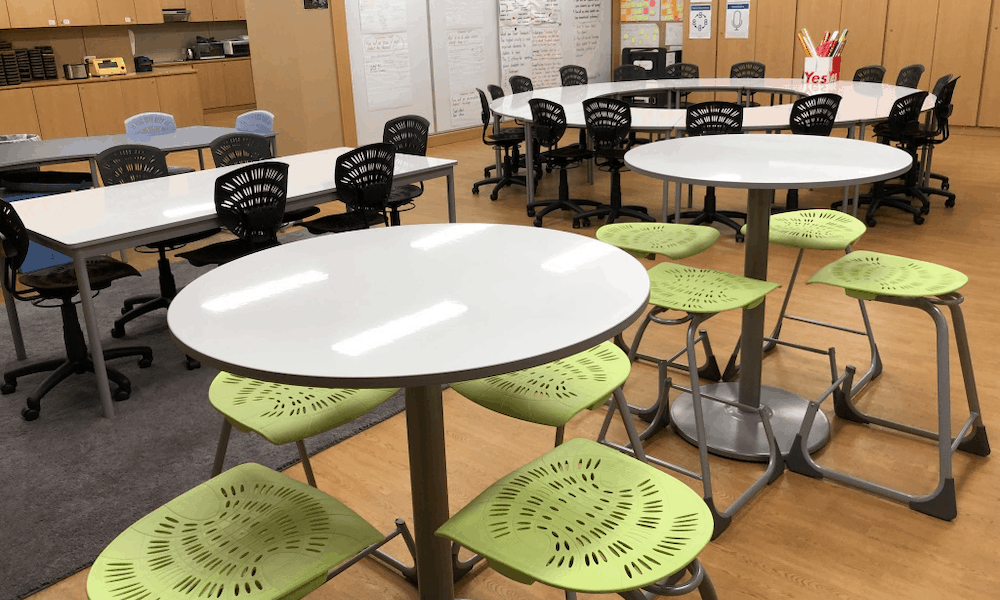Future Ready: The New Version of School

School leaders have about 90 days to get future ready. For many, it will require four infrastructure decisions and four innovation decisions.
This fall, many school districts, and networks will find themselves running a distanced onsite program and a remote program simultaneously. There will also be an increased demand for a full time online learning and hybrid options.
The four new or updated elements of future-ready infrastructure include a blended core program, a distanced onsite strategy, an updated remote program, and an online program.
1. Blend the core academic program. Many schools have spent five or 10 years blending digital tools and resources into their print-based curriculum and updating their instructional strategies. Some spent the last two months catching up.
Five years ago, our Implementation Guide 3.0 described blended learning as “a formal education program in which a student learns at least in part through online delivery of content and instruction with some element of student control over time, place, path, and/or pace at least in part at a supervised brick-and-mortar location away from home.”
A blended learning program is a learning management system (LMS) to manage content and assignments across different modes of learning (i.e., onsite and remote). Some districts put off a platform decision or allowed teachers to make their own decisions. But now is the time for schoolwide (if not districtwide) use of a common platform–the pandemic made it clear that education is officially a team sport and one where shared agility is mission-critical.
The second decision is defining a consistent approach to learning materials. That used to mean adopted textbooks but, in many cases, those can be replaced with high quality digital open educational resources and supplemented with teacher-developed content. The benefit of engaging asynchronous digital content became even more evident in the last two months.
A few platforms come loaded with content and embedded assessments that can provide a headstart for running full-time online schools (discussed below). Some innovative schools like Purdue Polytechnic in Indianapolis, use one of these platforms for personalized knowledge and skill development, and supplement it with big integrated community-connected projects.
One thing this pandemic made clear is the benefit of collaboration (workflow and project management) and communication tools (texting and video conferencing) to keep you and your team and students connected.
You won’t find a suite of tools that does everything you want but options are improving. Canvas from Instructure and Schoology from Powerschool are popular platforms. Google Classroom and G Suite and Microsoft Classroom, 365, and Teams aren’t full-featured learning management systems but they are integrated collaboration and communication ecosystems –and they’re free.
2. Update your remote strategy. Because learners–small and large groups– may be moving back and forth between remote and onsite learning it will be important to link modes of learning.
Staff members may also need to work remotely periodically requiring temporary staffing strategies–teachers and leaders will need to be especially flexible next year.
Schools may need to update plans for take home mobile technology and strengthen broadband partnerships (discounts, mobile and community hotspots), to reach as close to every household as possible.
3. Build a social distanced onsite solution. Use a combination of place-shifting (i.e., extra spaces) and time-shifting (i.e., staggered schedules) to build a social distancing solution if that’s how you have to start school. The decision will depend on the number of buses you have and the number of cycles they make. The number of parents that choose to have their children stay home and participate in remote (or online) learning will also influence this strategy. Some parents may also choose onsite learning but will avoid busing. In all cases, it will be important for school and district administrators to communicate with and survey parents/guardians frequently.
4. Start or partner with online school. With full and part-time enrollment, online schools are designed to support learning at home. Thousands of students transferred to online schools when school buildings closed and hundreds of thousands of students may follow over the next 18 months. As a result, school districts are scrambling to create online options to prevent further defections.
School districts that don’t have an online school, should start one or partner with one in their state. They can contract with a statewide provider, or license content from a statewide provider or assemble open content (like OpenEd from ACT), or use asynchronous content (like Edgenuity or Edmentum).
The new opportunity that someone will figure out in the next two years is combining the benefits of robust asynchronous content with project-based learning.
Every metropolitan area could use a cooperative online provider that provides online and hybrid (like two days a week onsite) options to families and a place for teachers that can’t teach in a school building–an online matching service for families looking for options and teachers needing alternative placement.
The four innovation opportunities (discussed in my next post) are work that matters, skills for thriving, meeting learners where they are, and responsive options.
Note: 3,400 school districts have pledged to be Future Ready Schools and are probably making progress in these four areas.
For more see:
- Pandemic Spike in AI Learning–and What it Means for Schools
- How to Reopen Schools: A 10-Point Plan Putting Equity at the Center
Stay in-the-know with innovations in learning by signing up for the weekly Smart Update.
This blog was originally posted on Forbes.








Mark Beadle
I appreciate the succinct nature of this post! Sometimes the details overwhelm us but these 4 ideas would let us get off our desk chairs (in our houses) and start planning. I liked the reminder we have about 90 days if we pla to re-open about Sept. 1.
Elizabeth Borgmann
I appreciate your words and detailed outline but being a kindergarten teacher, it’s difficult to fathom what the beginning of a virtual/online school year looks like. They’re still preschoolers and teaching by playing and using manipulatives is our way of learning. It’s overwhelming to think of trying to teach littles virtually. More guidance would be extremely helpful.
Craig Schieber
Are schools considering having teachers go to students rather than students to teachers? Teachers could go to a neighborhood cluster of students once a week and make rounds that way with all their students. Students could still go into the school building some days as well.
Craig Schieber